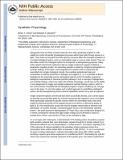Synthetic Physiology
Author(s)
Chow, Brian Y.; Boyden, Edward
DownloadBoyden_Synthetic physiology.pdf (268.3Kb)
OPEN_ACCESS_POLICY
Open Access Policy
Creative Commons Attribution-Noncommercial-Share Alike
Terms of use
Metadata
Show full item recordAbstract
Optogenetic tools are DNA-encoded molecules that, when genetically targeted to cells, enable the control of specific physiological processes within those cells through exposure to light. These tools can pinpoint how these specific processes affect the emergent properties of a complex biological system, such as a mammalian organ or even an entire animal. They can also allow control of a biological system for therapeutic or bioengineering purposes. Many of the optical control tools explored to date are single-component reagents containing a photoactive signaling domain. An interesting question is raised by comparing optogenetics to synthetic biology. In the latter, interchangeable and modular DNA-encoded parts are assembled into complex biological circuits, thus enabling sophisticated logic and computation as well as the production of biologics and reagents (1, 2). Is it possible to devise strategies for the temporally precise cell-targeted optical control of complex engineered biological computational or chemical-synthetic pathways? Such a marriage of optogenetics and synthetic biology—which one might call synthetic physiology—would open up the ability to use optogenetics to trigger and regulate engineered synthetic biology systems, which in turn could execute computational and biological programs of great complexity (3). On page 1565 of this issue, Ye et al. (4) explore such a hybrid approach to controlling a biological system, as well as the bioengineering and preclinical capabilities opened up by such an approach.
Date issued
2011-06Department
Massachusetts Institute of Technology. Department of Biological Engineering; Massachusetts Institute of Technology. Department of Brain and Cognitive Sciences; Massachusetts Institute of Technology. Media Laboratory; McGovern Institute for Brain Research at MIT; Program in Media Arts and Sciences (Massachusetts Institute of Technology)Journal
Science
Publisher
American Association for the Advancement of Science (AAAS)
Citation
Chow, B. Y., and E. S. Boyden. “Synthetic Physiology.” Science 332, no. 6037 (June 23, 2011): 1508-1509.
Version: Author's final manuscript
ISSN
0036-8075
1095-9203